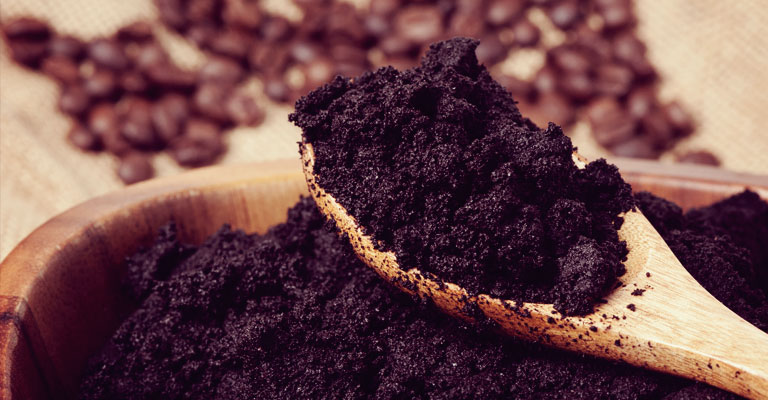
Coffee contains about 2% nitrogen by volume, making it an excellent ingredient for compost. This is one way to use up coffee grounds, but there are several other uses for them in the garden.
Some people mistakenly believe that coffee grounds are acidic and should only be used around acid-loving plants, such as azaleas. In fact, it’s not the grounds that are acidic, but the coffee bean itself. The pH of liquid coffee fluctuates between 4.85 and 5.10. But the used grounds vary between 6.5 and 6.8. Its pH is therefore almost neutral.
Here are 5 uses of coffee in the garden:
Coffee grounds can be added directly to the soil. It is placed at the base of plants, trees and shrubs, or incorporated into flower beds by lightly cultivating. Unbleached paper filters can also be added to soil as they break down quickly.
Coffee grounds gradually release nitrogen, phosphorus and potassium, which are the basic components of fertilizer. Although it is not in sufficient quantity to replace your usual fertilizer, its value nevertheless contributes to the growth of plants. As a bonus, it helps absorb heavy metals that might contaminate the soil and water.
Note that tomatoes, geraniums and lettuce do not particularly appreciate coffee grounds. In the first two cases, it inhibits their growth, while lettuce leaves tend to yellow and wither.
OUR TIP: Coffee grounds should be applied sparingly. Moreover, when used as mulch, it tends to form a crust which prevents the circulation of air and water. To avoid this phenomenon, mix it with compost, taking care that its proportion does not exceed 20%.
As is the case with you, coffee can invigorate a tired lawn. This will probably require more coffee grounds than you produce, but your favourite local coffee shop might be happy to offer you theirs.
Apply used coffee grounds at a standard rate of 1 cubic yard per 1,000 sq. ft. and distribute evenly with a push broom, making sure the lawn gets enough light. Water in after application is complete.
Diluted coffee can also be used as a liquid fertilizer for indoor or outdoor plants. Remember that coffee is acidic in itself. It must therefore be diluted before using it to fertilize a plant. It should obviously not contain milk or sweeteners that could cause the appearance of mold, fungus or disease.
When diluted, it should have the colour of a very light tea. Preferably, give the solution to plants that like acidity. Do not fertilize more than usual. Do this according to the needs of the plant and the time of year.
To make a liquid fertilizer out of used grounds, follow these steps:
Step 1.
Pour the grounds into a container with 2 litres of water.
Step 2.
Stir the mixture, then let it sit in a cool room (like a garage or basement) for 24 to 48 hours.
Step 3.
Filter the liquid to remove particles.
Step 4.
Water your plants with your homemade fertilizer.
Adding coffee grounds speeds up the process of turning waste vegetables into compost due to the enthusiasm of earthworms. If you do vermicomposting, we encourage you to add them to your bin.
According to a study, a compost containing coffee grounds is of better quality and emits less greenhouse gases. Some suggest the mixture should be 40% coffee grounds, while others recommend no more than 20%. A popular recipe also suggests making your compost using equal parts coffee grounds, shredded leaves and grass clippings, which would give about 30% here!
In short, if you make your own compost, coffee grounds are an element that should not be neglected, but you must also include a good proportion of vegetable matter and various table scraps. This way, even if your household consumes a lot of coffee, the quantities of grounds collected are unlikely to be excessive.
Note that worms love coffee grounds. Applying them to the garden will stimulate their appetite, increasing their production of nutrient-rich droppings. This improves the physical condition and structure of the soil.
Earthworms appreciate coffee grounds, but it doesn’t seem to be the case with slugs and snails. So why not use it to keep these pests away from the garden?
You can use coffee grounds as you might use ashes or sand, by spreading it at the base of the plants so as to circle the stems. To use it as an aphid repellent, mix the grounds with water and spray the plant. In the event of an infestation, however, an insecticidal soap such as Wilson BUG-X OUT should be used.
Also remember to reuse coffee containers! Large formats can be used as pots, if you run out! If you plant plants there, do not forget to drill drainage holes at the bottom to drain excess water if necessary.
Subscribe to our newsletter to receive our gardening tips, news and more directly in your inbox! Fill in the form below. Please note that fields with an * are required.